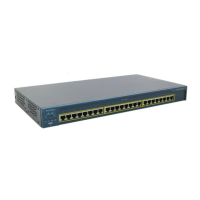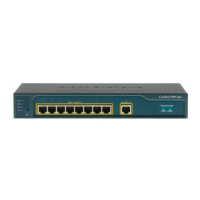13-11
Catalyst 2950 and Catalyst 2955 Switch Software Configuration Guide
78-11380-12
Chapter 13 Configuring STP
Configuring Spanning-Tree Features
Configuring Spanning-Tree Features
These sections describe how to configure spanning-tree features:
• Default Spanning-Tree Configuration, page 13-11
• Spanning-Tree Configuration Guidelines, page 13-12
• Changing the Spanning-Tree Mode, page 13-13 (required)
• Disabling Spanning Tree, page 13-14 (optional)
• Configuring the Root Switch, page 13-14 (optional)
• Configuring a Secondary Root Switch, page 13-16 (optional)
• Configuring the Port Priority, page 13-17 (optional)
• Configuring the Path Cost, page 13-18 (optional)
• Configuring the Switch Priority of a VLAN, page 13-20 (optional)
• Configuring Spanning-Tree Timers, page 13-20 (optional)
Default Spanning-Tree Configuration
Table 13-3 shows the default spanning-tree configuration.
Table 13-3 Default Spanning-Tree Configuration
Feature Default Setting
Enable state Enabled on VLAN 1.
For more information, see the “Supported
Spanning-Tree Instances” section on
page 13-9.
Spanning-tree mode PVST+. (Rapid PVST+ and MSTP are
disabled.)
Switch priority 32768.
Spanning-tree port priority (configurable on a per-interface basis) 128.
Spanning-tree port cost (configurable on a per-interface basis) 1000 Mbps: 4.
100 Mbps: 19.
10 Mbps: 100.
Spanning-tree VLAN port priority (configurable on a per-VLAN basis) 128.
Spanning-tree VLAN port cost (configurable on a per-VLAN basis) 1000 Mbps: 4.
100 Mbps: 19.
10 Mbps: 100.
Spanning-tree timers Hello time: 2 seconds.
Forward-delay time: 15 seconds.
Maximum-aging time: 20 seconds.

